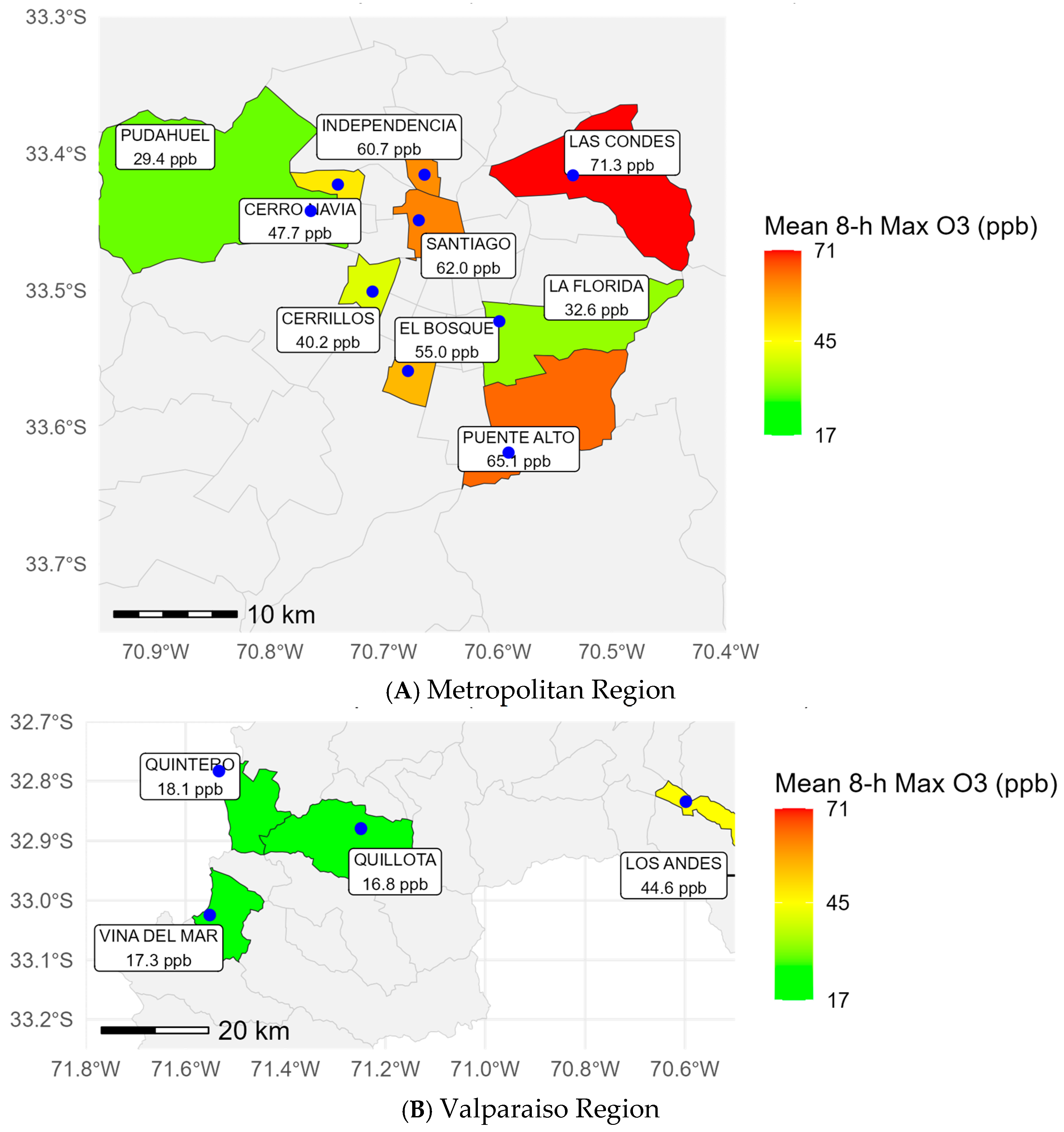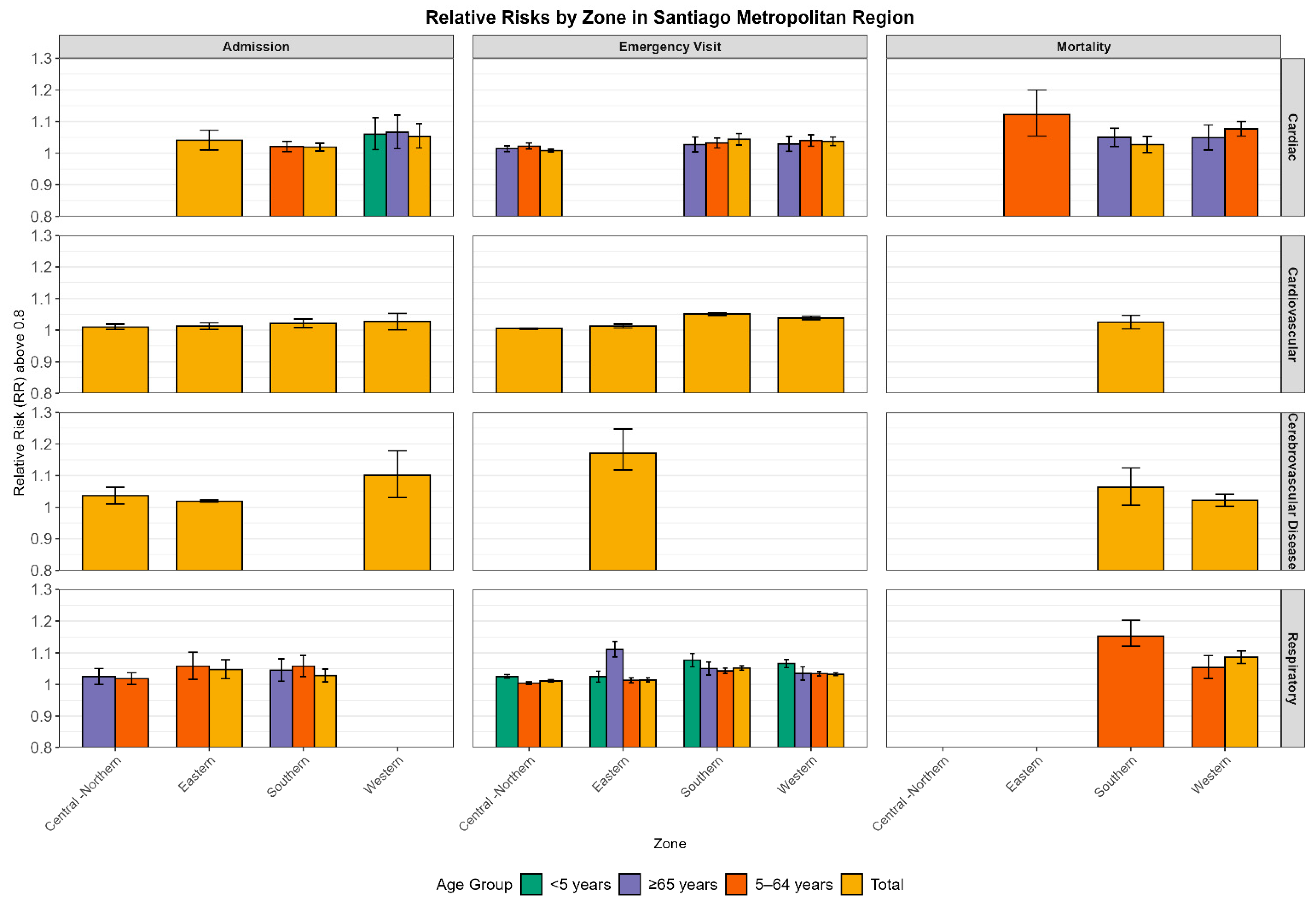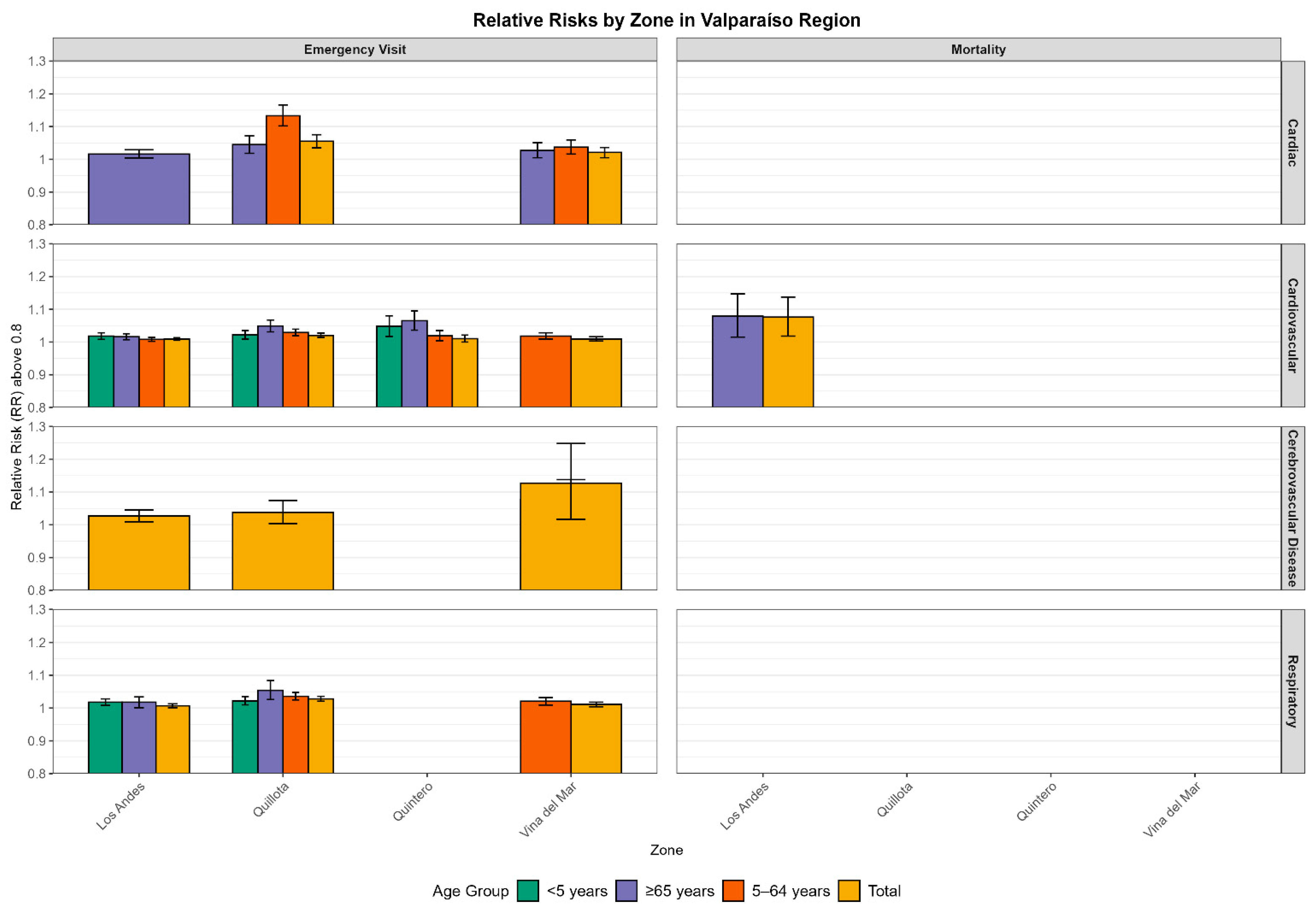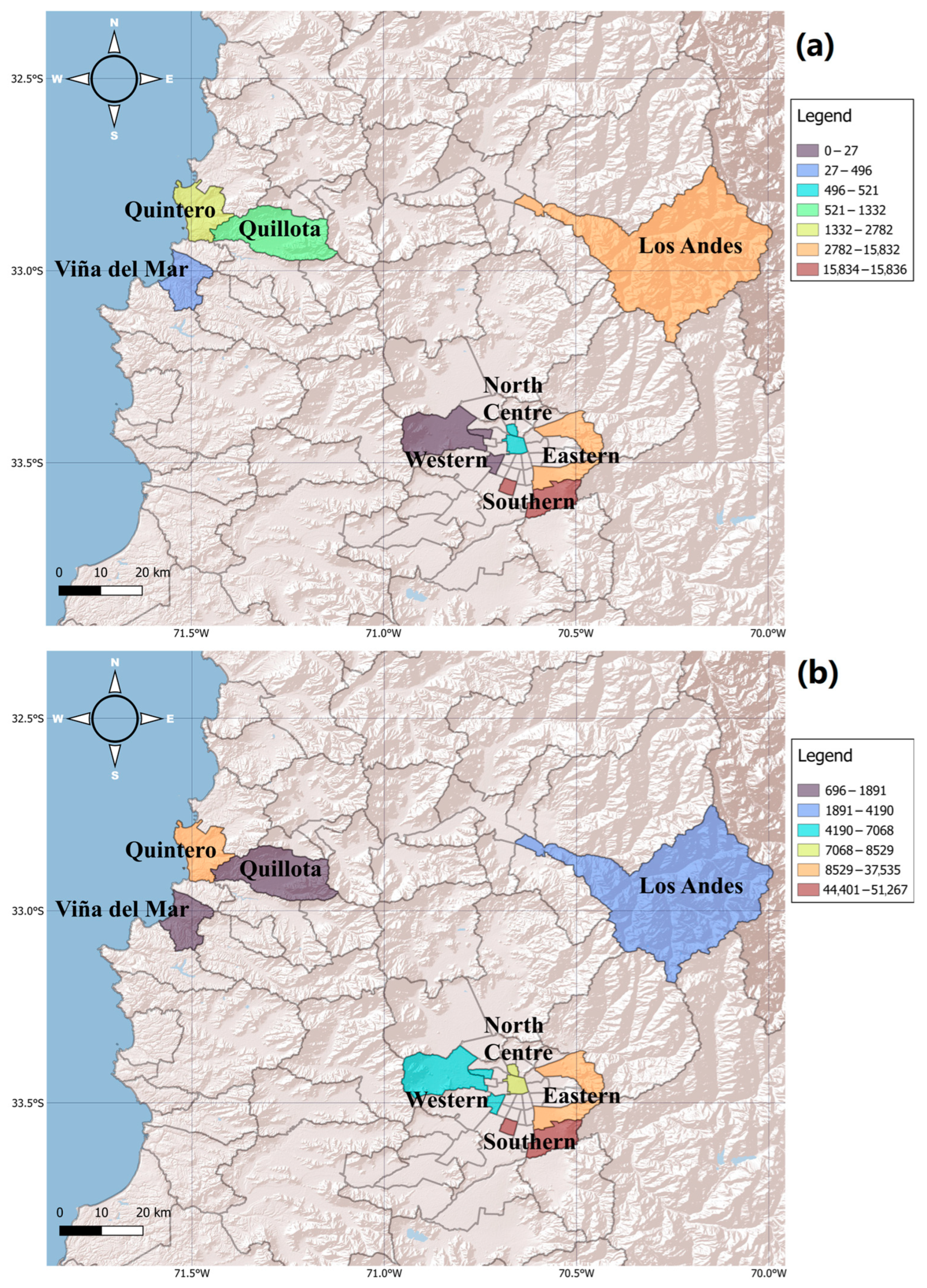Health and Economic Benefits of Ozone Reduction: Case Study in Santiago and Valparaíso
Abstract
1. Introduction
2. Methods
2.1. Study Area
2.2. Data Preprocessing and Imputation
2.3. Statistical Analysis
- Baseline Model: The initial model incorporated seasonality (via natural cubic splines) and day-of-the-week effects to account for temporal patterns, establishing a foundation to isolate ozone’s impact from background variability in health data across the Santiago Metropolitan and Valparaíso Regions.
- Meteorological Adjustments: A cross-correlation analysis of the baseline model’s residuals with meteorological variables (e.g., temperature, humidity) identified significant predictors (z-value > 1.96, 95% confidence level) and their optimal lags. This step reduced meteorological confounding, thereby improving the accuracy of RR estimates, particularly in coastal zones such as Valparaíso, where sea breezes significantly influence pollutant dispersion.
- Pollutant Adjustments: Residuals from the meteorologically adjusted model were cross-correlated with confounding pollutants (e.g., PM2.5, NO2). Significant contributors and their lags were retained, while non-significant variables were excluded to avoid overfitting, ensuring robust RR calculations for specific outcomes (e.g., cardiovascular mortality in Los Andes).
- Ozone Effect Estimation: Ozone was incorporated into the model with empirically determined lags using the gam.exact algorithm within the Generalized Additive Model (GAM) framework [33], providing precise standard errors for the coefficients. The RR was calculated as follows in Equation (2):
2.4. Health Impact and Economic Valuation
3. Results and Discussions
3.1. Relative Risks in the Santiago Metropolitan Region
3.2. Relative Risks in the Valparaíso Region
3.3. Avoided Cases
3.4. Economic Benefits
4. Conclusions
Supplementary Materials
Author Contributions
Funding
Data Availability Statement
Acknowledgments
Conflicts of Interest
References
- Freeman, B.S.; Taylor, G.; Gharabaghi, B.; Thé, J. Forecasting air quality time series using deep learning. J. Air Waste Manag. Assoc. 2018, 68, 866–886. [Google Scholar] [CrossRef]
- Stoyanov, N.; Pandelova, A.; Georgiev, T.; Kalapchiiska, J.; Dzhudzhev, B. Forecasting of Air Pollution with Time Series and Multiple Regression Models in Sofia, Bulgaria. J. Environ. Eng. Landsc. Manag. 2023, 31, 176–185. [Google Scholar] [CrossRef]
- Manisalidis, I.; Stavropoulou, E.; Stavropoulos, A.; Bezirtzoglou, E. Environmental and Health Impacts of Air Pollution: A Review. Front. Public Health 2020, 8, 505570. [Google Scholar] [CrossRef] [PubMed]
- Buchholz, R.R.; Paton-Walsh, C.; Griffith, D.W.T.; Kubistin, D.; Caldow, C.; Fisher, J.A.; Deutscher, N.M.; Kettlewell, G.; Riggenbach, M.; Macatangay, R.; et al. Source and meteorological influences on air quality (CO, CH4 & CO2) at a Southern Hemisphere urban site. Atmos. Environ. 2016, 126, 274–289. [Google Scholar] [CrossRef]
- Wang, L.; Lun, X.; Wang, Q.; Wu, J. Biogenic volatile organic compounds emissions, atmospheric chemistry, and environmental implications: A review. Environ. Chem. Lett. 2024, 22, 3033–3058. [Google Scholar] [CrossRef]
- Feron, S.; Cordero, R.R.; Damiani, A.; Oyola, P.; Ansari, T.; Pedemonte, J.C.; Wang, C.; Ouyang, Z.; Gallo, V. Compound climate-pollution extremes in Santiago de Chile. Sci. Rep. 2023, 13, 6726. [Google Scholar] [CrossRef]
- Cui, B.; Xian, C.; Han, B.; Shu, C.; Qian, Y.; Ouyang, Z.; Wang, X. High-resolution emission inventory of biogenic volatile organic compounds for rapidly urbanizing areas: A case of Shenzhen megacity, China. J. Environ. Manag. 2024, 351, 119754. [Google Scholar] [CrossRef]
- Lyu, X.; Li, K.; Guo, H.; Morawska, L.; Zhou, B.; Zeren, Y.; Jiang, F.; Chen, C.; Goldstein, A.H.; Xu, X.; et al. A synergistic ozone-climate control to address emerging ozone pollution challenges. One Earth 2023, 6, 964–977. [Google Scholar] [CrossRef]
- Parra, R.; Cadena, E.; Flores, C. Maximum UV index records (2010–2014) in Quito (Ecuador) and its trend inferred from remote sensing data (1979–2018). Atmosphere 2019, 10, 787. [Google Scholar] [CrossRef]
- Zhang, C.; Stevenson, D. Characteristic changes of ozone and its precursors in London during COVID-19 lockdown and the ozone surge reason analysis. Atmos. Environ. 2022, 273, 118980. [Google Scholar] [CrossRef]
- Campos, V.; Díaz-Robles, L.; Fadic, X.; Ruggeri, M.F.; Vallejo, F.; Barcaza, G.; Fu, J.S.; Cereceda-Balic, F. High levels and behavior of tropospheric ozone in the Andes Mountains, Central Chile. In Proceedings of the EGU General Assembly 2024, Vienna, Austria, 14–19 April 2024; p. 13411. [Google Scholar] [CrossRef]
- Guo, P.; Su, Y.; Sun, X.; Liu, C.; Cui, B.; Xu, X.; Ouyang, Z.; Wang, X. Urban–Rural Comparisons of Biogenic Volatile Organic Compounds and Ground-Level Ozone in Beijing. Forests 2024, 15, 508. [Google Scholar] [CrossRef]
- Zalakeviciute, R.; Lopez-Villada, J.; Ochoa, A.; Moreno, V.; Byun, A.; Proaño, E.; Mejía, D.; Bonilla-Bedoya, S.; Rybarczyk, Y.; Vallejo, F. Urban Air Pollution in the Global South: A Never-Ending Crisis? Atmosphere 2025, 16, 487. [Google Scholar] [CrossRef]
- Vallejo, F.; Villacrés, P.; Yánez, D.; Espinoza, L.; Bodero-Poveda, E.; Díaz-Robles, L.A.; Oyaneder, M.; Campos, V.; Palmay, P.; Cordovilla-Pérez, A.; et al. Prolonged Power Outages and Air Quality: Insights from Quito’s 2023–2024 Energy Crisis. Atmosphere 2025, 16, 274. [Google Scholar] [CrossRef]
- Chen, Y.-H.R.; Lee, W.-C.; Liu, B.-C.; Yang, P.-C.; Ho, C.-C.; Hwang, J.-S.; Huang, T.-H.; Lin, H.-H.; Lo, W.-C. Quantifying the potential effects of air pollution reduction on population health and health expenditure in Taiwan. Environ. Pollut. 2023, 336, 122405. [Google Scholar] [CrossRef]
- Kheirbek, I.; Wheeler, K.; Walters, S.; Kass, D.; Matte, T. PM2.5 and ozone health impacts and disparities in New York City: Sensitivity to spatial and temporal resolution. Air Qual. Atmos. Health 2013, 6, 473–486. [Google Scholar] [CrossRef]
- Zhou, J.; Gladson, L.; Díaz Suárez, V.; Cromar, K. Respiratory Health Impacts of Outdoor Air Pollution and the Efficacy of Local Risk Communication in Quito, Ecuador. Int. J. Environ. Res. Public Health 2023, 20, 6326. [Google Scholar] [CrossRef]
- Pino-Cortés, E.; Díaz-Robles, L.A.; Campos, V.; Vallejo, F.; Cubillos, F.; Gómez, J.; Cereceda-Balic, F.; Fu, J.; Carrasco, S.; Figueroa, J. Effect of socioeconomic status on the relationship between short-term exposure to PM2.5 and cardiorespiratory mortality and morbidity in a megacity: The case of Santiago de Chile. Air Qual. Atmos. Health 2020, 13, 509–517. [Google Scholar] [CrossRef]
- Kaur, J.; Singh, S.; Parmar, K.S. Forecasting of AQI (PM2.5) for the three most polluted cities in India during COVID-19 by hybrid Daubechies discrete wavelet decomposition and autoregressive (Db-DWD-ARIMA) model. Environ. Sci. Pollut. Res. 2023, 30, 101035–101052. [Google Scholar] [CrossRef]
- Gómez, M.C.; Durana, N.; García, J.A.; de Blas, M.; Sáez de Cámara, E.; García-Ruiz, E.; Gangoiti, G.; Torre-Pascual, E.; Iza, J. Long-term measurement of biogenic volatile organic compounds in a rural background area: Contribution to ozone formation. Atmos. Environ. 2020, 224, 117315. [Google Scholar] [CrossRef]
- Cazorla, M.; Trujillo, M.; Seguel, R.; Gallardo, L. Comparative ozone production sensitivity to NO x and VOCs in Quito, Ecuador, and Santiago, Chile. Atmos. Chem. Phys. 2025, 25, 7087–7109. [Google Scholar] [CrossRef]
- Lapere, R.; Menut, L.; Mailler, S.; Huneeus, N. Seasonal variation in atmospheric pollutants transport in central Chile: Dynamics and consequences. Atmos. Chem. Phys. 2021, 21, 6431–6454. [Google Scholar] [CrossRef]
- Seguel, R.J.; Castillo, L.; Opazo, C.; Rojas, N.Y.; Nogueira, T.; Cazorla, M.; Gavidia-Calderón, M.; Gallardo, L.; Garreaud, R.; Carrasco-Escaff, T.; et al. Changes in South American surface ozone trends: Exploring the influences of precursors and extreme events. Atmos. Chem. Phys. 2024, 24, 8225–8242. [Google Scholar] [CrossRef]
- Vallejo, F.; Yánez, D.; Viñán-Guerrero, P.; Díaz-Robles, L.A.; Oyaneder, M.; Reinoso, N.; Billartello, L.; Espinoza-Pérez, A.; Espinoza-Pérez, L.; Pino-Cortés, E. Enhancing air quality predictions in Chile: Integrating ARIMA and Artificial Neural Network models for Quintero and Coyhaique cities. PLoS ONE 2025, 20, e0314278. [Google Scholar] [CrossRef] [PubMed]
- Reyer, C.P.O.; Adams, S.; Albrecht, T.; Baarsch, F.; Boit, A.; Canales Trujillo, N.; Cartsburg, M.; Coumou, D.; Eden, A.; Fernandes, E.; et al. Climate change impacts in Latin America and the Caribbean and their implications for development. Reg. Environ. Change 2017, 17, 1601–1621. [Google Scholar] [CrossRef]
- Herrera, P.; Rojo, J.; Scapini, V. Relationship between pollution levels and poverty: Regions of Antofagasta, Valparaiso and Biobio, Chile. Int. J. Energy Prod. Manag. 2022, 7, 176–184. [Google Scholar] [CrossRef]
- Garcia-Santos, Y.; Narváez, D.A.; Saldías, G.S.; Jacques-Coper, M.; Bozkurt, D.; Garreaud, R.; Valdés-Castro, V. Impact of atmospheric rivers on coastal oceanographic conditions off central-southern Chile. Sci. Rep. 2025, 15, 34569. [Google Scholar] [CrossRef]
- Borhani, F.; Motlagh, M.S.; Rashidi, Y.; Ehsani, A.H. Estimation of short-lived climate forced sulfur dioxide in Tehran, Iran, using machine learning analysis. Stoch. Environ. Res. Risk Assess. 2022, 36, 2847–2860. [Google Scholar] [CrossRef]
- Kamboj, K.; Sisodiya, S.; Mathur, A.K.; Zare, A.; Verma, P. Assessment and Spatial Distribution Mapping of Criteria Pollutants. Water Air Soil Pollut. 2022, 233, 82. [Google Scholar] [CrossRef]
- R Core Team. R: A Language and Environment for Statistical Computing. Vienna, Austria, 2024. v. 2025.05.1. Available online: https://www.r-project.org/ (accessed on 16 September 2025).
- Alkabbani, H.; Ramadan, A.; Zhu, Q.; Elkamel, A. An Improved Air Quality Index Machine Learning-Based Forecasting with Multivariate Data Imputation Approach. Atmosphere 2022, 13, 1144. [Google Scholar] [CrossRef]
- Fann, N.; Lamson, A.D.; Anenberg, S.C.; Wesson, K.; Risley, D.; Hubbell, B.J. Estimating the National Public Health Burden Associated with Exposure to Ambient PM 2.5 and Ozone. Risk Anal. 2012, 32, 81–95. [Google Scholar] [CrossRef]
- Seguel, R.J.; Gallardo, L.; Osses, M.; Rojas, N.Y.; Nogueira, T.; Menares, C.; De Fatima Andrade, M.; Belalcázar, L.C.; Carrasco, P.; Eskes, H.; et al. Photochemical sensitivity to emissions and local meteorology in Bogotá, Santiago, and São Paulo: An analysis of the initial COVID-19 lockdowns. Elementa 2022, 10, 00044. [Google Scholar] [CrossRef]
- Sacks, J.D.; Fann, N.; Gumy, S.; Kim, I.; Ruggeri, G.; Mudu, P. Quantifying the public health benefits of reducing air pollution: Critically assessing the features and capabilities of WHO’s AirQ+ and U.S. EPA’s environmental benefits mapping and analysis program-community edition (BenMAP-CE). Atmosphere 2020, 11, 516. [Google Scholar] [CrossRef] [PubMed]
- Ministerio de Energía. Compendio Cartográfico Regionalizado: Proyectos de Energías Renovables en Chile; Ministerio de Energía: Santiago, Chile, 2015; pp. 1–35.
- Jitt-Aer, K.; Wall, G.; Jones, D.; Teeuw, R. Use of GIS and dasymetric mapping for estimating tsunami-affected population to facilitate humanitarian relief logistics: A case study from Phuket, Thailand. Nat. Hazards 2022, 113, 185–211. [Google Scholar] [CrossRef]
- Fu, P.; Kawamura, K.; Chen, J.; Miyazaki, Y. Secondary production of organic aerosols from biogenic VOCs over Mt. Fuji, Japan. Environ. Sci. Technol. 2014, 48, 8491–8497. [Google Scholar] [CrossRef] [PubMed]
- Garcia-Santos, Y.; Narváez, D.A.; Jacques-Coper, M.; Saldías, G.S.; Bozkurt, D.; Alessio, B.M. Dominant Wind Patterns Under the Influence of Atmospheric Rivers: Implications for Coastal Upwelling off Central-Southern Chile. J. Geophys. Res. Ocean. 2025, 130, e2024JC021444. [Google Scholar] [CrossRef]
- Huang, D.; Andersson, H.; Zhang, S. Willingness to pay to reduce health risks related to air quality: Evidence from a choice experiment survey in Beijing. J. Environ. Plan. Manag. 2018, 61, 2207–2229. [Google Scholar] [CrossRef]
- Ren, B.; Xie, P.; Xu, J.; Li, A.; Qin, M.; Hu, R.; Zhang, T.; Fan, G.; Tian, X.; Zhu, W.; et al. Vertical characteristics of NO2 and HCHO, and the ozone formation regimes in Hefei, China. Sci. Total Environ. 2022, 823, 99–109. [Google Scholar] [CrossRef]
- Seguel, R.J.; Gallardo, L.; Fleming, Z.L.; Landeros, S. Two decades of ozone standard exceedances in Santiago de Chile. Air Qual. Atmos. Health 2020, 13, 593–605. [Google Scholar] [CrossRef]
- Cereceda-Balic, F.; Gala-Morales, M.; de la Palomo-Marín, R.; Fadic, X.; Vidal, V.; Funes, M.; Rueda-Holgado, F.; Pinilla-Gil, E. Spatial distribution, sources, and risk assessment of major ions ad trace elements in rainwater at Puchuncaví Valley, Chile: The impact of industrial activities. Atmos. Pollut. Res. 2020, 11, 99–109. [Google Scholar] [CrossRef]
- Seguel, R.J.; Mancilla, C.A.; Rondanelli, R.; Leiva, M.A.; Morales, R.G.E. Ozone distribution in the lower troposphere over complex terrain in Central Chile. J. Geophys. Res. Atmos. 2013, 118, 2966–2980. [Google Scholar] [CrossRef]
- Cazorla, M.; Herrera, E.; Palomeque, E.; Saud, N. What the COVID-19 lockdown revealed about photochemistry and ozone production in Quito, Ecuador. Atmos. Pollut. Res. 2021, 12, 124–133. [Google Scholar] [CrossRef] [PubMed]
- Monks, P.S.; Archibald, A.T.; Colette, A.; Cooper, O.; Coyle, M.; Derwent, R.; Fowler, D.; Granier, C.; Law, K.S.; Mills, G.E.; et al. Tropospheric ozone and its precursors from the urban to the global scale from air quality to short-lived climate forcer. Atmos. Chem. Phys. 2015, 15, 8889–8973. [Google Scholar] [CrossRef]
- Diaz-Robles, L.A.; Cortés, S.; Vergara-Fernández, A.; Ortega, J.C. Short Term Health Effects of Particulate Matter: A Comparison between Wood Smoke and Multi-Source Polluted Urban Areas in Chile. Aerosol Air Qual. Res. 2015, 15, 306–318. [Google Scholar] [CrossRef]
- Jeon, W.B.; Lee, S.H.; Lee, H.; Park, C.; Kim, D.H.; Park, S.Y. A study on high ozone formation mechanism associated with change of NOx/VOCs ratio at a rural area in the Korean Peninsula. Atmos. Environ. 2014, 89, 10–21. [Google Scholar] [CrossRef]
- Silva, J.S.; Rojas, J.P.; Norabuena, M.; Seguel, R.J. Ozone and volatile organic compounds in the metropolitan area of Lima-Callao, Peru. Air Qual. Atmos. Health 2018, 11, 993–1008. [Google Scholar] [CrossRef]
- Seguel, R.J.; Garreaud, R.; Muñoz, R.; Bozkurt, D.; Gallardo, L.; Opazo, C.; Jorquera, H.; Castillo, L.; Menares, C. Volatile organic compounds measured by proton transfer reaction mass spectrometry over the complex terrain of Quintero Bay, Central Chile. Environ. Pollut. 2023, 330, 121759. [Google Scholar] [CrossRef]
- EPA. “BenMAP.” 2025. Available online: https://www.epa.gov/benmap/benmap-downloads (accessed on 16 September 2025).
- World Health Organization. Air Pollution and Health: Summary of Evidence. 2021, p. 300. Available online: https://www.who.int/publications/i/item/9789240034228 (accessed on 15 September 2025).
- Ballesteros-González, K.; Sullivan, A.P.; Morales-Betancourt, R. Estimating the air quality and health impacts of biomass burning in northern South America using a chemical transport model. Sci. Total Environ. 2020, 739, 139755. [Google Scholar] [CrossRef]
- Olawepo, J.O.; Chen, L.W.A. Health benefits from upgrading public buses for cleaner air: A case study of Clark County, Nevada and the United States. Int. J. Environ. Res. Public Health 2019, 16, 720. [Google Scholar] [CrossRef]
- Sanhueza, P.A.; Torreblanca, M.A.; Diaz-Robles, L.A.; Schiappacasse, L.N.; Silva, M.P.; Astete, T.D. Particulate Air Pollution and Health Effects for Cardiovascular and Respiratory Causes in Temuco, Chile: A Wood-Smoke-Polluted Urban Area. J. Air Waste Manag. Assoc. 2009, 59, 1481–1488. [Google Scholar] [CrossRef]




| Region/Zone | Primary Standard Benefits (USD) | WHO Recommendation Benefits (USD) |
|---|---|---|
| Metropolitan—Central-North | 73,532,280 | 1,040,141,720 |
| Metropolitan—Eastern | 1,712,238,280 | 3,792,211,840 |
| Metropolitan—Southern | 616,790,400 | 2,123,562,360 |
| Metropolitan—Western | 2,823,440 | 484,014,720 |
| Valparaíso—Viña del Mar | 98,086,320 | 137,451,760 |
| Valparaíso—Quintero | 51,561,920 | 401,625,920 |
| Valparaíso—Los Andes | 316,144,320 | 430,977,600 |
| Valparaíso—Quillota | 53,724,680 | 74,513,520 |
Disclaimer/Publisher’s Note: The statements, opinions and data contained in all publications are solely those of the individual author(s) and contributor(s) and not of MDPI and/or the editor(s). MDPI and/or the editor(s) disclaim responsibility for any injury to people or property resulting from any ideas, methods, instructions or products referred to in the content. |
© 2025 by the authors. Licensee MDPI, Basel, Switzerland. This article is an open access article distributed under the terms and conditions of the Creative Commons Attribution (CC BY) license (https://creativecommons.org/licenses/by/4.0/).
Share and Cite
Vallejo, F.; Villacrés, P.; Leiva-González, J.; Pino-Cortés, E.; Espinoza-Pérez, L.; Espinoza-Pérez, A.; Díaz-Robles, L.; Castro, P.; Campos, V.; Zalakeviciute, R. Health and Economic Benefits of Ozone Reduction: Case Study in Santiago and Valparaíso. Earth 2025, 6, 134. https://doi.org/10.3390/earth6040134
Vallejo F, Villacrés P, Leiva-González J, Pino-Cortés E, Espinoza-Pérez L, Espinoza-Pérez A, Díaz-Robles L, Castro P, Campos V, Zalakeviciute R. Health and Economic Benefits of Ozone Reduction: Case Study in Santiago and Valparaíso. Earth. 2025; 6(4):134. https://doi.org/10.3390/earth6040134
Chicago/Turabian StyleVallejo, Fidel, Patricio Villacrés, Jorge Leiva-González, Ernesto Pino-Cortés, Lorena Espinoza-Pérez, Andrea Espinoza-Pérez, Luis Díaz-Robles, Pablo Castro, Valeria Campos, and Rasa Zalakeviciute. 2025. "Health and Economic Benefits of Ozone Reduction: Case Study in Santiago and Valparaíso" Earth 6, no. 4: 134. https://doi.org/10.3390/earth6040134
APA StyleVallejo, F., Villacrés, P., Leiva-González, J., Pino-Cortés, E., Espinoza-Pérez, L., Espinoza-Pérez, A., Díaz-Robles, L., Castro, P., Campos, V., & Zalakeviciute, R. (2025). Health and Economic Benefits of Ozone Reduction: Case Study in Santiago and Valparaíso. Earth, 6(4), 134. https://doi.org/10.3390/earth6040134









